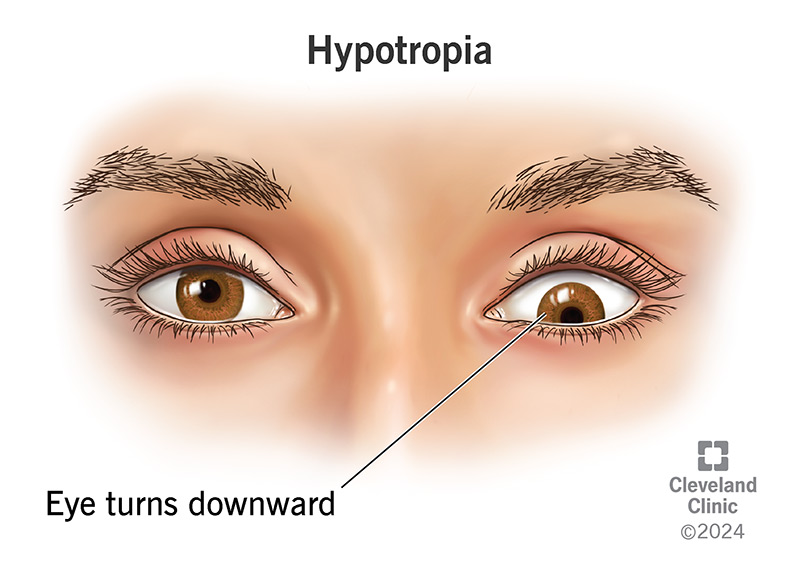Hypotropia is a type of eye misalignment (strabismus) where one eye points downward relative to the other. This impairs your binocular vision and depth perception. Injuries and disorders that affect your eye muscles or the nerves that control them can cause it. Treatment may include vision correction, vision therapy or surgery.
Advertisement
Cleveland Clinic is a non-profit academic medical center. Advertising on our site helps support our mission. We do not endorse non-Cleveland Clinic products or services. Policy

Hypotropia is a form of eye misalignment (strabismus) in which your eye turns downward involuntarily. It’s the opposite of hypertropia (an upward eye turn). You may have hypotropia by itself, or your eye may drift downward and to one side. Hypotropia with esotropia (an inward turn) often occurs with a condition called heavy eye syndrome. Hypotropia can also occur with exotropia (an outward turn).
Advertisement
Cleveland Clinic is a non-profit academic medical center. Advertising on our site helps support our mission. We do not endorse non-Cleveland Clinic products or services. Policy
Hypotropia can be:
When you have hypotropia, you can’t control your wayward eye movements, and you may not even realize they’re happening. Children with this condition may be too young to understand how their eyes are different. This can be both socially and physically awkward. Whether you’re a child or the parent of that child, or even an adult developing hypotropia, it can bring a variety of challenges — not all of them visual.
When your eyes won’t coordinate, it can cause binocular vision dysfunction, with symptoms including:
Some people develop a head tilt in the effort to see better, which can cause neck stiffness and pain. Head tilts in children can affect how they grow. For example, they may develop asymmetrical faces.
Advertisement
Hypotropia might affect you a little or a lot, depending on how often it happens and how severe it is. You might have difficulty or discomfort with tasks that require close vision, like reading or sewing. Eye misalignment in children can worsen over time. In some cases, it can lead to amblyopia (lazy eye). This is more likely if the child is younger, which is why regular screenings from an early age are so important.
Hypotropia happens when something prevents the muscles around your eye from moving it up and down normally. Disorders or injuries that affect these muscles may weaken, pull or trap them. Sometimes the nerves that activate these muscles are unable to do so. Disorders or injuries that affect your nervous system can damage these nerve pathways. There are many possible causes, including:
Eye care specialists diagnose hypotropia with a thorough eye exam and specialized tests. These tests help them determine the degree of eye misalignment you have and how it’s affecting your vision.
Tests may include:
You may need other tests, or to see another healthcare provider, to diagnose the underlying cause of your misalignment. This is important because the cause will determine the best treatment approach.
Advertisement
The treatment depends on the cause. In some cases, treating the cause will correct hypotropia. In other cases, it won’t. You might need to wear prescription lenses and prisms to correct your vision.
Depending on the cause, nonsurgical treatments can sometimes fix hypotropia. Your provider will try these options first. If they don’t work, they might recommend surgery to fix it. Strabismus surgery adjusts the muscles around your eye to correct the misalignment. It corrects the appearance of hypotropia and will often correct your vision. But some people may still need corrective lenses and prisms.
With early diagnosis and treatment, the prognosis (outlook) is good. Hypotropia that goes untreated too long may be harder to treat later. In children, untreated hypotropia can lead to loss of depth perception or amblyopia (lazy eye) and permanent vision loss in the affected eye. It’s daunting to send a young child into eye surgery. But children who have surgery when it’s recommended have excellent outcomes.
Whether your child is born with it, or whether you develop it later in life, hypotropia can be unsettling and disorienting. We expect and depend on our eyes to work together. When one goes astray, it disrupts our vision, our image and our orientation in space. The good news is that it’s treatable, and with timely treatment, it’s often curable. For the best outcome, see your eye care provider sooner than later.
Advertisement
Getting an annual eye exam at Cleveland Clinic can help you catch vision problems early and keep your eyes healthy for years to come.

Last reviewed on 11/18/2024.
Learn more about the Health Library and our editorial process.